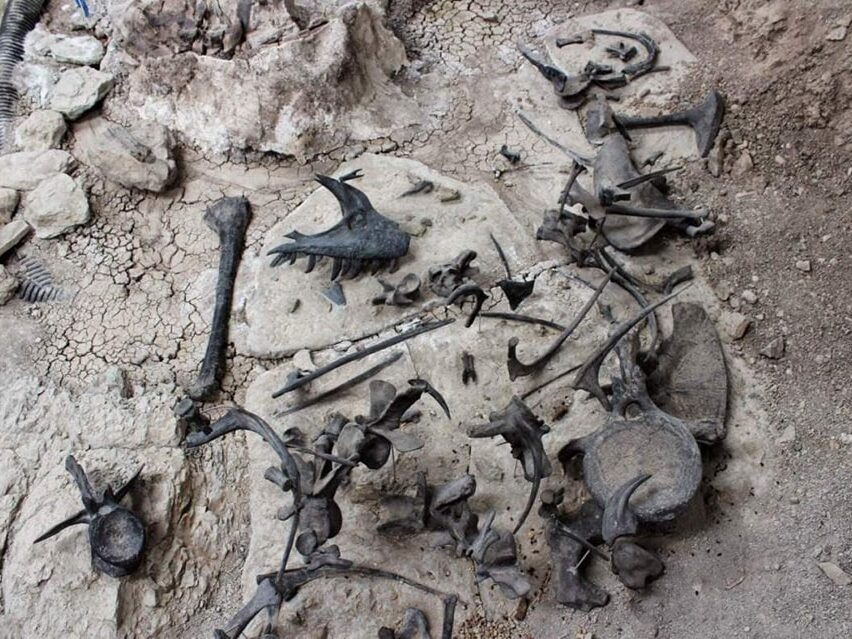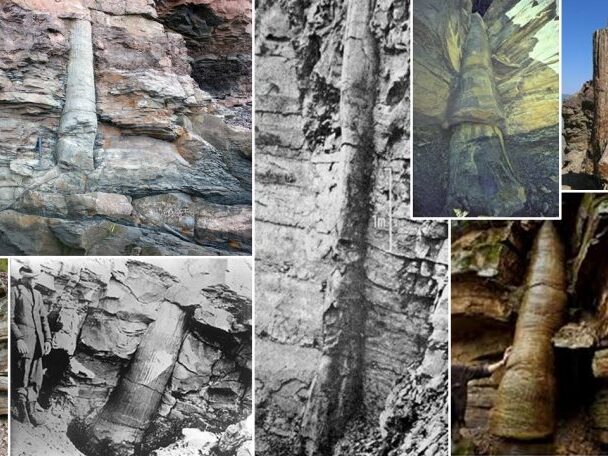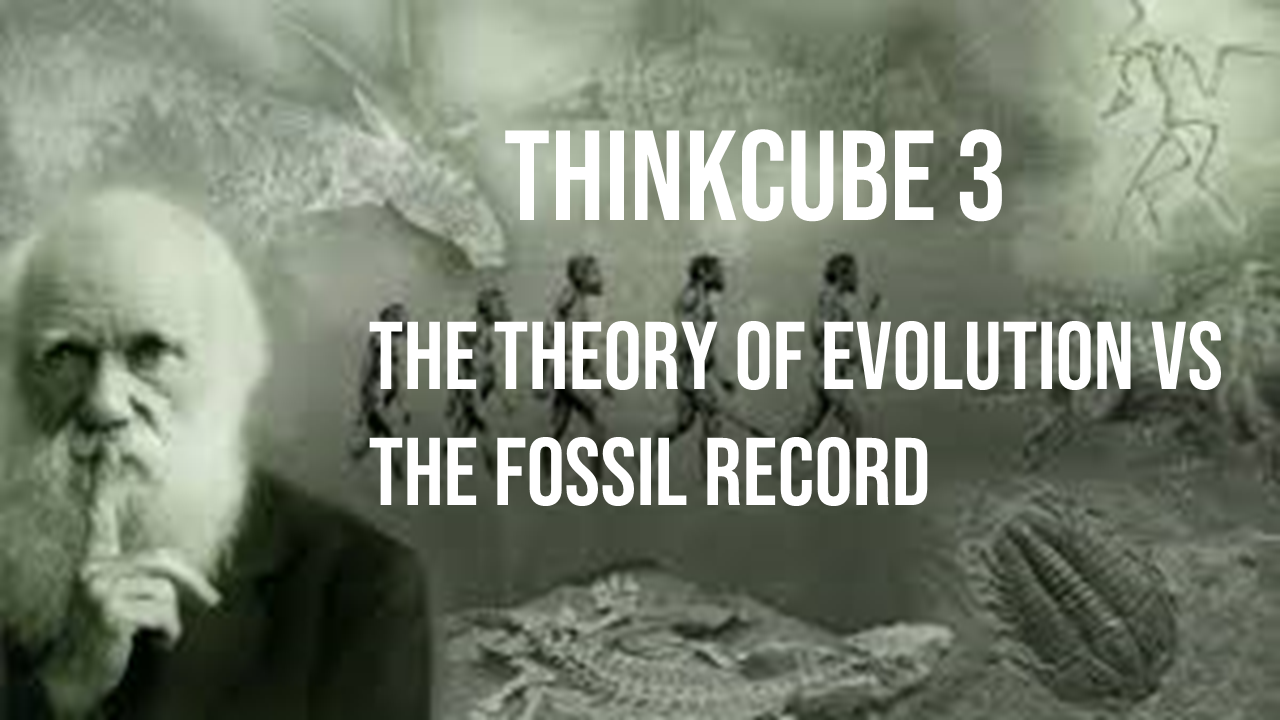
Premise 1: The transitional fossils the theory of evolution would require are not there
The core prediction of Darwin’s theory of evolution is gradualism, which means that all the transitional changes in the history of life are not supposed to have happened as sudden big changes which could be seen as miraculous, but by a continuous accumulation of small changes over vast periods of time. Therefore, he mentioned not fewer than six times in On the Origin of Species the Latin phrase Natura non facit saltus, which means that nature does not make jumps.
The theory of evolution proposes that all the organic beings which have every lived on this earth have descended from some primordial form and that complex organisms and organs were formed by micro-mutations (small infinitesimal changes) occurring individually and sporadically over millions of years. If this is true, then the fossil record should be full of organisms fossilized in their in-between species states or what paleontologist call “transitionals”.
A transitional represents a distinct change in a species becoming stronger in it’s own class, or a change from one species to another. Evolutionists believe that amphibians, reptiles, mammals, and birds evolved after fish— that the first amphibians evolved from a lobe-finned fish ancestor about 365 million years ago. And that Mammals and birds both evolved from reptile-like ancestors.
Evolutionist believe that fish evolved into reptiles, and reptiles into birds— However, none of the fossils in the world’s most extensive fossil beds have revealed a reptile with distinct fish characteristics such as gills or fins, or reptiles with any bird characteristics such as feathers, or the essential avian lung. Yet there are countless fossils of fully formed reptiles, fish and birds without a hint of transitional characteristics.

According to the evolutionary chain birds evolved from dinosaurs and scientists claim that in the process of transformation over millions of years dinosaurs shrank down to the size of birds. Once again, none of the fossil beds reveal dinosaur species shrinking but staying the same size as when the species first appears in the fossil record— there are no fossils showing transitions from dinosaurs to birds even though there should be countless examples.
If Darwin’s theory were true, transitional creatures such as invertebrates with partially developed backbones, fish with partially formed legs legs, reptiles with primitive wings and innumerable creatures with semi-evolved anatomical features should be the rule, scattered throughout the fossil strata.
Although each of these classes [fishes, amphibians, reptiles, mammals and primates] are well represented in the fossil record, yet no one has discovered a fossil creature that is indisputably transitional between one species and another species. Not a single undisputed ‘missing link’ has been found in all the exposed rocks of the Earth’s crust despite the most careful and extensive searches.
How extensive has the search been? How complete is the fossil record?
Charles Darwin knew that the fossil record as it stood during his time did not support his theory.
Why, if species have descended from other species by insensibly fine gradations, do we not everywhere see innumerable transitional forms? Why is not all nature in confusion instead of the species being, as we see them, well defined?”
“… The number of intermediate varieties, which have formerly existed on the earth, (must) be truly enormous. Why then is not every geological formation and every stratum full of such intermediate links?
Darwin excused the lack of transitional discovery on the fact that exploration of the fossil record was still in it’s infancy. However, due to the extensive exploration and documentation of the world’s biggest fossil beds this is no longer a valid excuse.
Modern paleontology has led to unprecedented fossil collection, documentation and research. Numerous major fossil beds have been discovered around the world using advances such as ultrasound, 3 D scanning, sonar, and satellite technology.
Of the 329 living families of terrestrial vertebrates (mammals, birds, reptiles and amphibians) 261 or 79.1 percent have been found as fossils — when birds (which are poorly fossilized) are excluded, the percentage rises to 87.8 percent
Michael Denton; Biological Researcher, Evolution: A Theory in Crisis p. 189)
Here are just a 10 of the 600 major fossil beds that are listed on Wikepedia “List of Fossil Sites” that represent sites found in all four corners of the globe:
- Argentina, South America: Largest Fossil Beds in South America
- Hells Creek, United States: Arguably the most famous fossil site in the world.
- Joggins Fossil Cliffs, Canada: Home of one of world’s most important Carboniferous sites
- Jurassic Coast, England: According to Paleontologists documents 185 years of Earth’s History
- Stanska Skala, Czech Republic: Home of one of most important Pleistocene fossil sites in Europe
- Jiufotang Formation, China: Early Cretaceous Period around 120 million years ago
- Gobi Desert, Africa: Largest dinosaur fossil reservoir in the world.
- Messel Pit Fossil Site, Germany: Richest site in the world for understanding the environment of the Eocene Era
- Alexander Island, Anarctica: One of three major fossil bed sites on the South Pole.
- Prince Creek, North Pole: One of many sites found in the Artic
The Ukhaa Tolgod which is the greatest Gobi fossil bed found to date was found using a NASA satellite from space. After over 150 years of of fossil collecting and 200 million plus fossils found the dominant fossil trend is anatomical sameness—Zero transitionals.
All of the major fossil beds on the Wikepedia list of 600 reveal fossils fully developed with no transitional forms. Species appear in the fossil record looking the same as when they disappear.
To date, scientists worldwide have catalogued some 200 million large fossils and billions of small fossils.
The Three Museums with some of the largest collections of fossil specimens:
- Smithsonian Museum of Natural History: 40 million
- American Museum of Natural History: 4.5 million
- British Museum of Natural History: 80 million
The American Museum of Natural History house over 4.5 million fossil specimens. It has the The first fossil collected for American Museum of Natural History was in 1897. It has the world’s largest amphibian, reptile and bird collection in the world. All of the specimens reflect fully formed bird, reptile and amphibian species, none are transitional forms.
In a private letter to Dr. Luther Sunderland, Dr. Colin Patterson of the British Museum of Natural History author of the book “Evolution” wrote the following:
“I fully agree with your comments on the lack of of direct illustrations of evolutionary transitions in my book. If I knew of any such fossil I certainly would have included them.
I will lay it on the line…There is not one such fossil for which one might make a watertight argument.“
Charles Darwin predicted that once the fossil record was complete that not only would numerous transitions would be found; but he actually believed that the fossil record would be made up of mostly transitions.
The number of intermediate and transitional links, between all living and extinct species, must have been inconceivably great.
Charles Darwin; The Origin of Species, page 355
Extensive fossil recovery and exploration has revealed the exact opposite. As Darwin stated this should not be the case at all if the Theory of Evolution were true.
Even ardent proponents of evolution struggle to explain why advances in fossil exploration have not uncovered any transitional fossils
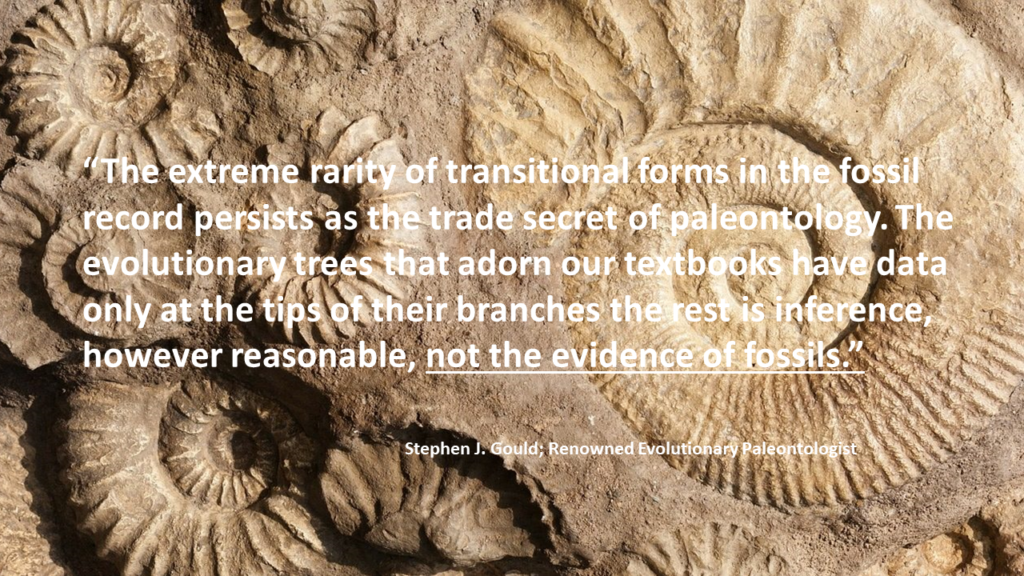
The fossil record does not convincingly document a single transition from one species to another.” In addition, species remain fundamentally unchanged for an average of more than one million years before disappearing from the record.
Steven M. Stanley is an American paleontologist and evolutionary biologist at the University of Hawaii at Manoa. He is best known for his empirical research documenting the evolutionary process of punctuated equilibrium in the fossil record. Yale University. National Book Award Science, Penrose Medal, Guggenheim Fellowship For Natural Science
The missing link between man and apes…is merely the most glamorous of a whole hierarchy of phantom creatures. In the fossil record, missing links are the rule…The more scientist have searched for the transitional forms between species, the more they have been frustrated
Newsweek (Is Man a Subtle Accident?)
Almost 88 percent of the varieties of mammals, reptiles, and amphibians have been found in the fossil record. Fish, amphibians, reptiles, mammals and primates are all well represented there has not been even one indisputable transitional link been found despite the most extensive searches.
Charles Darwin in his Origin of Species, Chapter 6 “Difficulties On Theory” described the lack of missing links in the fossil record as “the gravest objection which can be urged against my theory.” This was a massive concern of Darwin and he was honest enough as a scientist to admit it publicly.
Challenge Question : If Evolution is true—then why haven’t the countless millions of transitional fossils been found anywhere on the globe?
Premise 2: The Fossil Record shows species appearing in the record where they are not supposed to be
Fossil formations across the globe lend credence to the lack of harmony in the fossil record. The Thomas Fork Formation in Wyoming contains fossil snails, fish scales, turtle carapaces, reptile bones, and dinosaur eggshells, which should not all be found together
John A. Dorr; Museum of Paleontology, University of Michigan
The Bighorn Basin in Wyoming contains a continuous local record of fossil deposits for about five million years during an early period in the age of mammals. Because this record is so complete, paleontologists assumed that certain populations of the basin could be linked together to illustrate continuous evolution. On the contrary, species that were once thought to have turned into others turn out to overlap in time with their alleged descendants.
This chart shows the widely accepted evolutionary timeline for animal phyla.. However the fossil record shows massive overlap of species being before or after where they were supposed to be according to the evolutionary timeline.
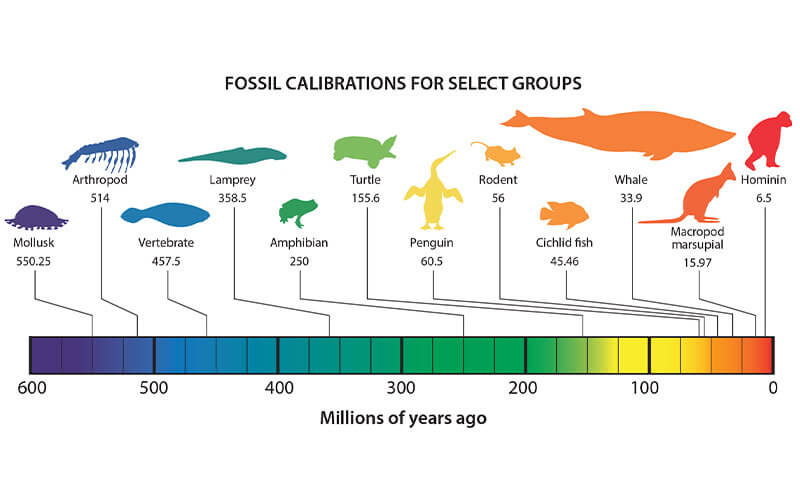
For example evolutionist believe that birds evolved from reptiles over millions of years yet they both appear together in fossils throughout the fossil record. Evolutionists believe reptiles evolved 315 million years ago, and birds evolved 150 million years ago—a 165 million year gap yet they appear together in all of the world’s major fossil beds.
A study from North Carolina State University in January of 2005 announced that a fossil specimen from Antarctica had been identified as a duck, flipping the evolutionary script. Ducks, some argued, were not supposed to have diverged from their ancestral forms until after the Cretaceous period. Yet this fossil was dated to the late Cretaceous period approximately 70 million years ago, according to evolutionists. This showed that modern birds existed with the dinosaurs they are supposed to have evolved from. The History Files
In 2005 researchers in China identified a small dinosaur known as Psittacosaurus amongst the stomach region of a fossilized furry mammal that resembled a Tasmanian devil. To find such an advanced predatory mammal came as a surprise to these researchers. The evolutionists had long maintained that the only mammals alive at the time of the dinosaurs were very small and unadvanced.
Finding a bird, duck, tasmanian devil or otherwise during the Cretaceous period would be like escavating the ruins of King Tut’s Palace and finding a 2024 Ford Mustang parked in the garage. These are not evolutionary anomalies, these should be considered evolutionary impossibilities.
Dr. Carl Werner, biologist and author of Living Fossils developed a fossil-related criteria as a test for the validity of evolution. He reasoned that if dinosaurs lived in a unique “Age of Reptiles” as evolution theory postulates, and if everyday natural processes were responsible for their fossilization—then no fossils of creatures from other “ages” or creatures that should not have evolved yet should be found with Dinosaur fossils.
Dr. Werner visited 60 natural history museums and ten dinosaur dig sites in seven different countries to interview various paleontologists. With each interview he found out that many modern bird species had been found with dinosaurs. The list included parrots, penguins, owls, sandpipers, albatross, flamingos, loons, ducks, cormorants and avocets.
Dr. Werner found that fossil mixture of very different kinds were typical. Dr. Werner found that dinosaur-containing rock layers have “fossilized examples from every major invertebrate animal phylum living today,” and that dinosaurs were mixed in with varieties of fish, amphibians, parrots, owls, penguins, ducks, loons, albatross, cormorants, sandpipers, avocets, etc.
Werner was astonished to find that in order to protect the viability of the established evolutionary timeline —all of the museums refused to display any dinosaur fossils that had other animals in them. Doing so would publicize the fact that birds did not evolve from dinosaurs or reptiles and that the whole evolutionary timeline as well as predicted species progression is bogus.
Dr. Werner to Creation magazine:
Paleontologists have found 432 mammal species in the dinosaur layers….But where are these fossils at the museums? We visited 60 museums but did not see a single complete mammal skeleton from the dinosaur layers displayed at any of these museums.
Every time you see a T.rex or Tricertatops in a museum display, you should also see ducks, loons, flamingos or some of these other modern birds that have been found in the same rock layers as these dinosaurs
Dr. Carl Werner; Evolution The Grand Experiment
Museums, textbooks, and published paleontology research deliberately omit pictures and documentation of innumerable fossils that contradict the established evolutionary timeline but they cannot delete the fossil beds themselves.
The Ashley Beds in South Carolina is an enormous phosphate graveyard that contains mixed remains of man with land and sea animals, notably dinosaurs, pleisosaurs, whales, sharks, rhinos, horses, mastodons, mammoths, porpoises, elephants, deer, pigs, dogs, and sheep. Basically, it shouldn’t exist if evolution were true. These species are supposed to be descendants of each other—yet the appear together during an ancient period when most of these species should not have even existed yet.
Challenge Question: Does the fact that species that are supposed to be descendants of each other appear together fully formed together when they should not have exited yet cast grave doubt on the Theory of Evolution? What do you make of scientific journals, museum curators, and textbook publishers deliberately omitting pictures or documentation of these common findings?
Premise 3: Complex life forms appear in the fossil record where only simple life forms should found?
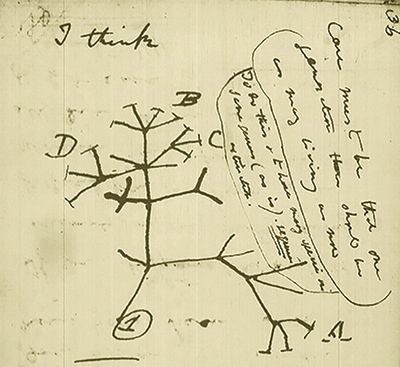
While Charles Darwin did not have the access to the extensive fossil documentation paleontologist have today the Cambrian Explosion deeply troubled him. At the time Origin of Species was published in 1859, the earliest fossil layer (the Cambrian) was called the Silurian. The Silurian troubled Darwin because complex life appears suddenly and completely in the earliest layers of the fossil record where only simple life forms should be found.
Consequently, if my theory be true, it is indisputable that before the lowest Silurian stratum was deposited, long periods elapsed, as long as, or probably far longer than, the whole interval from the Silurian age to the present day; and that during these vast, yet quite unknown, periods of time, the world swarmed with living creatures. To the question why we do not find records of these vast primordial periods, I can give no satisfactory answer
Charles Darwin; The Origin of Species page 307
Essentially Charles Darwin is stating what should be obvious to everyone at this point—albeit using 19th century vernacular:
If simple single-celled organisms evolved over millions of years into multi-celled organisms then at the earliest fossil layers which represent the beginning of evolutionary time—there should not be complex life forms where only simple life forms should be… right?
Evolutionists claim the Cambrian rock layers were first laid down about 540 million years ago. Albeit, highly complex multicellular creatures known as metazoans and a plethora of hard-shelled creatures suddenly appear in these sedimentary strata. Examples include clams, snails, horseshoe crabs, trilobites, sponges, brachiopods, worms, jellyfish, sea urchins, sea cucumbers, starfish, brittle stars, sea lilies, and other complex invertebrates. These complex organisms appear millions of years before the evolutionary timeline predicted or the theory of descent with modification would permit.
Not only do fossil beds reveal descendent species showing up at the same time, but it begs the question of why is there complexity in the oldest part of the fossil record? Complexity being found in the bottom time era of the fossil record defies how evolution is supposed to work. If evolution is true, there should only be simple life forms at the bottom of the fossil record.
Harry F. Sanders (Answers In Depth) October 5, 2018
Discrepancies with the accepted evolutionary timeline occur throughout the fossil record
In 1994 in eastern Australia a park officer found a living Wollemi Pine Tree which was long thought to be extinct. The living pine tree looks exactly like its 91 million year old fossil without any evolution.
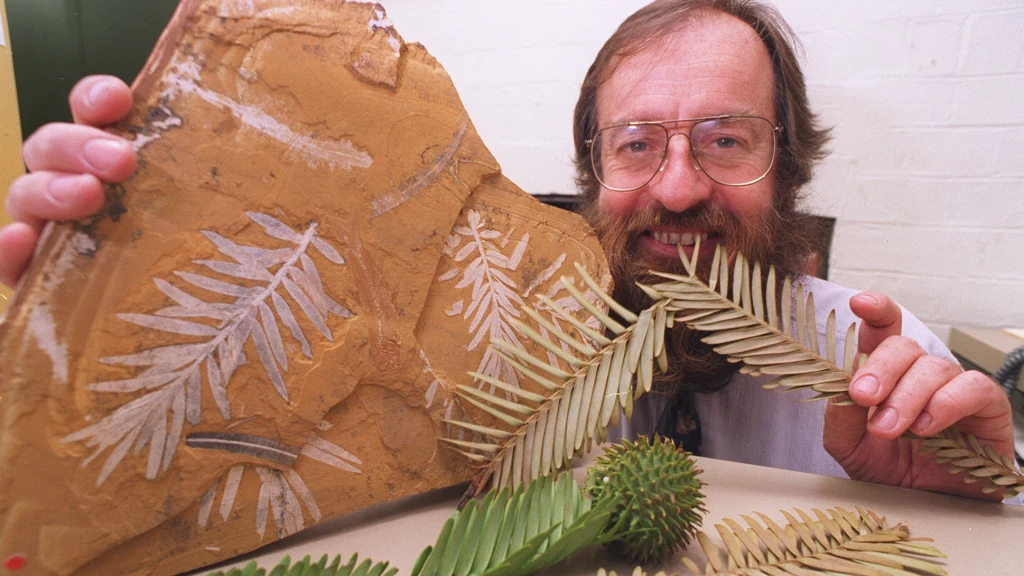
Here are pictures of full grown trees up from the bottom of the fossil strata where only simple fungi should have existed.
Pollen grains have been found in Precambrian layers, rocks thought to have been laid down a billion years before pollen-producing plants were supposed to have evolved.
The discovery of vascular wood and six-legged, composite-eyed insects in the Precambrian salt deposits of the Salt Range in Pakistan is also highly problematic for evolutionists.
Sahni, B., “Microfossils and the Salt Range Thrust,” Proceedings of the NAS, India, 1945, pp. i-xix.)
Stromalotites create even more evolutionary timeline confusion
Stromatolites are biologically derived rocks formed by colonies of microbes that live in shallow marine waters. Stromatolites are made by a single-celled organism called cyanobacteria. Previously known as blue-green algae, cyanobacteria came onto the scene about 3500 million years ago, well before the existence of any other complex life forms. They are the oldest type of photosynthetic organism in the world—so old, in fact, that they predate plants by a couple of billion years.
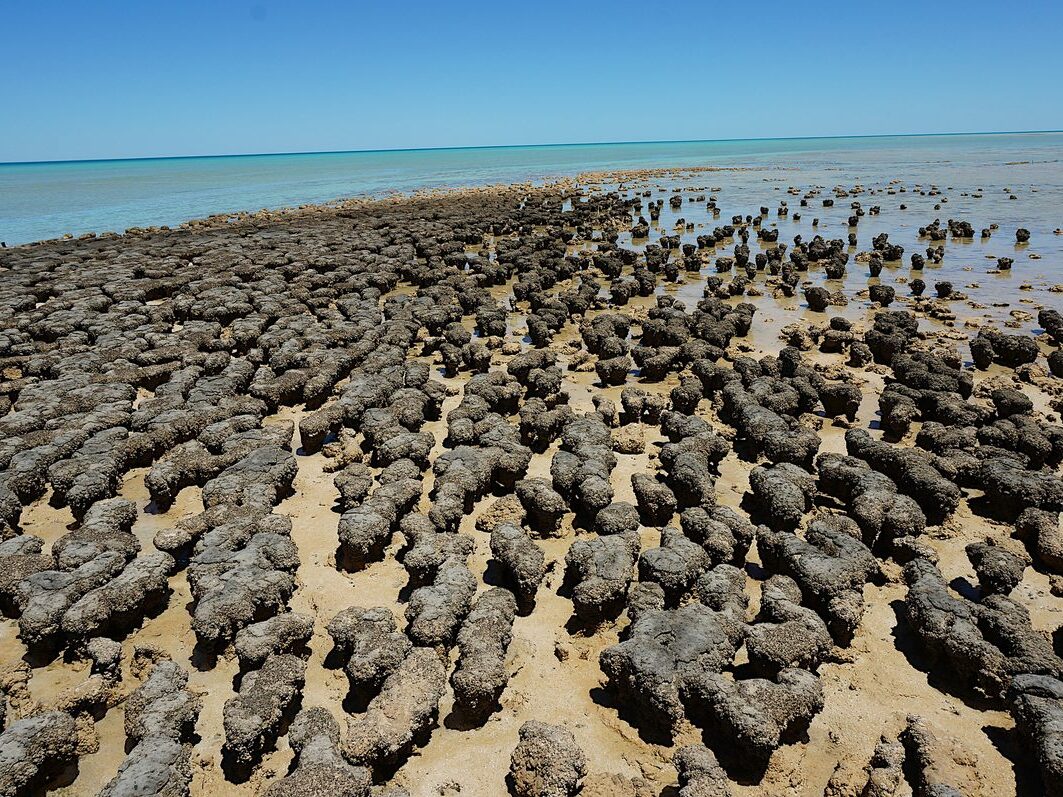
Stromatolites found by scientist in Greenland are now thought to be the oldest evidence of life yet discovered that that push the origin of life to at least 3.7 billion years into the past—the problem is this was a time when our earth was thought to have been experiencing harsh conditions unfavorable to the emergence of life and the thriving existence of complex photosynthesizing bacteria.
The great age of stromatolite fossils complicates the task of restructuring the evolution of life from the chemicals naturally present on earth—It leaves comparatively little time for evolution to have occurred and puts the process close to a time when Earth was being bombarded by destructive asteroids
New York Times (World’s Oldest Fossils Found In Greenland) August 31, 2016
Challenge Question: The chief pillar of the Theory of Evolution is descent with modification over millions of years—Doesn’t finding examples of complex life forms such as Stromatolites during the era of the Earth’s history when life was just beginning cast doubt on the whole theory?
Premise 4: “Living Fossils” remain unchanged over supposed hundreds of millions of years
Living fossils is a term for species in existence today but also have been around long enough to form fossils millions of years ago. Living fossils are not an oddity, they appear throughout the fossil layers. Almost every species of living animal has an ancestor that has been found in the fossil record.
Some examples are the coelacanth fish (fossil coelacanths are believed by evolutionist to be 340 million years old), Gingko trees (125 million years), crocodiles (140 million years), horseshoe crabs (200 million years), Neopilina mollusks (500 million years), and the Tuatara lizard (200 million years)
The challenge for evolutionists is that all the living fossils that have been found are identical to the species alive today and show no sign of the evolutionary process whatsoever.
These images demonstrate the absence of directional change over time which completely violates evolutionary theory
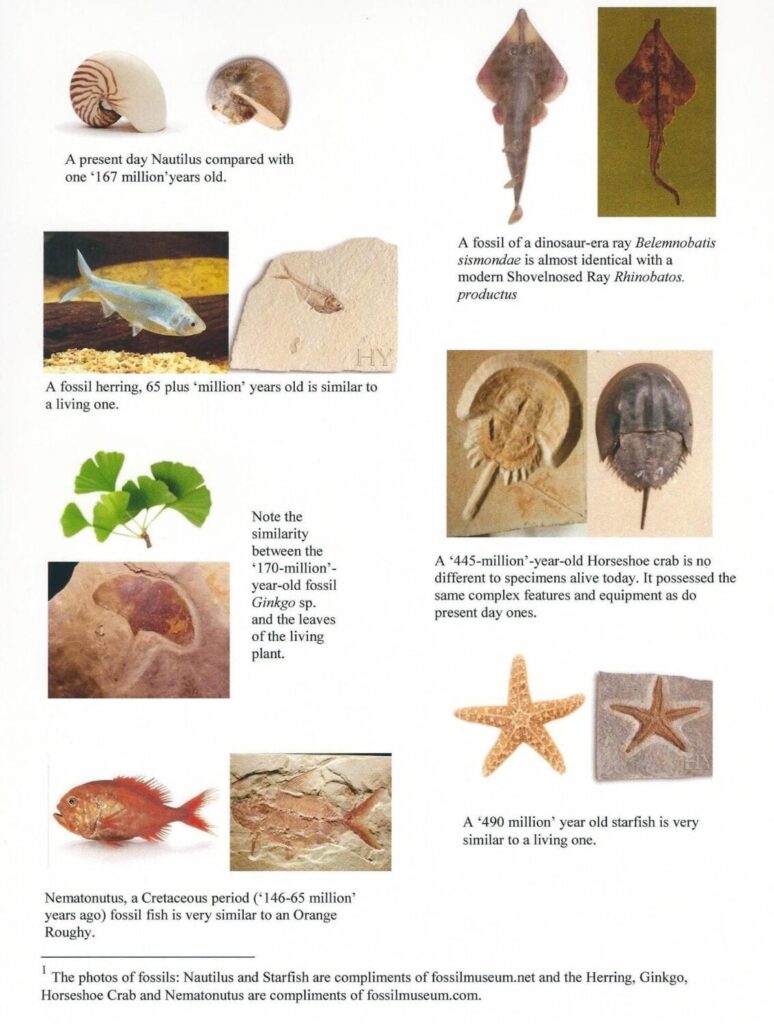
Why have these life-forms stayed the same for all that time?
New Scientist Article-The Creatures Time Forgot 1999
A variety of animals have been preserved in fossilized tree amber including: insects, crustaceans, tadpoles, frogs, lizards, annelids, snails, and spiders. The hair of mammals has been found as well. Living fossils preserved in amber provide vivid windows that also show no directional change of species from where they were supposedly millions of years ago and what they look like today.
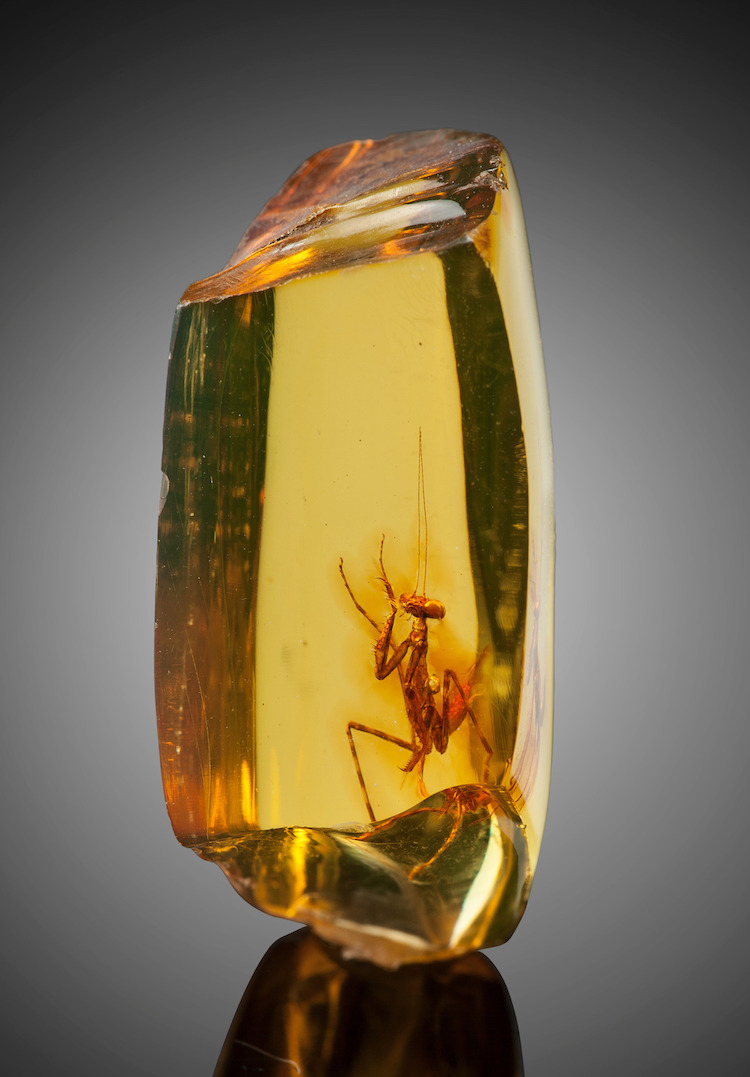

Sponges, squirrels, sharks, aardvarks, nautilaus, brachiopods, ginkgo trees, coalacanth, shrimp, frogs, rays, rabbits rats, platypus, ferns, crocodiles, pelicans, snails, dragonflies…the list goes on an on—these living fossils show Zero evolution. The fossil record indicates sudden appearance of all of these species fully formed identical to the way they appear today.
The abrupt manner in which whole groups of species suddenly appear in certain formations, has been urged by several paleontologists—for instance by Aggassiz, Picted, and by none more forcibly than by Professor Sedgewick as a fatal objection to the belief in the transmutation of species. If numerous species, belonging to the same genera or families, have really started into life all at once, the fact would be fatal to the theory of descent with slow modification through natural selection
Charles Darwin; Origin of Species, Page 327
Challenge Question : Evolution is defined as the gradual change in the characteristics of a species over several generations and yet paleontologist have found numerous “living fossils” that show organisms fully formed early in the fossil record that have remained unchanged over millions of years. How can this be explained if evolution is true?
ThinkCubed Truth Veracity Grid
Have I Considered the issue carefully and honestly with an open mind?
Does what I think conform to the rules of logic and avoid contradictions?
Are my conclusions free from bias or presuppositions?

